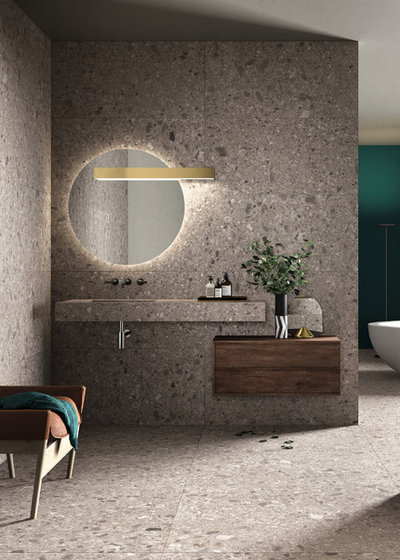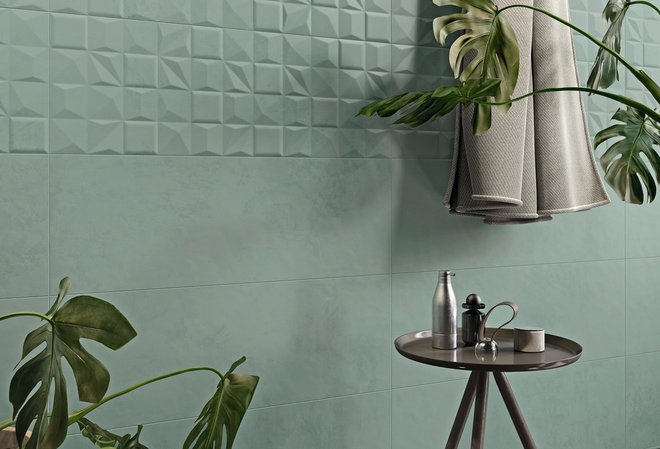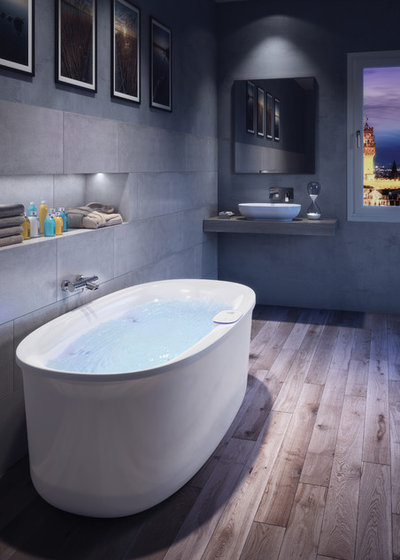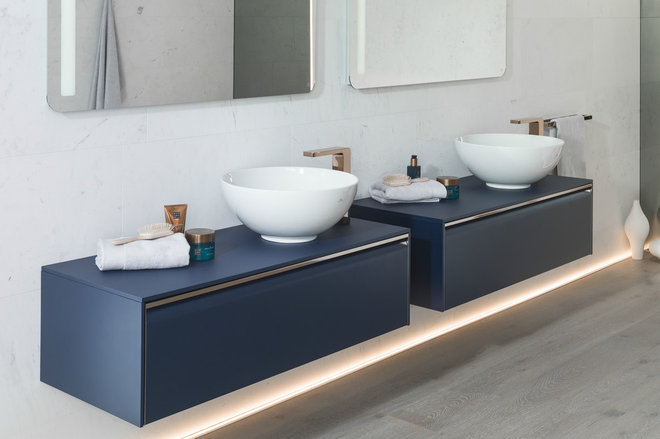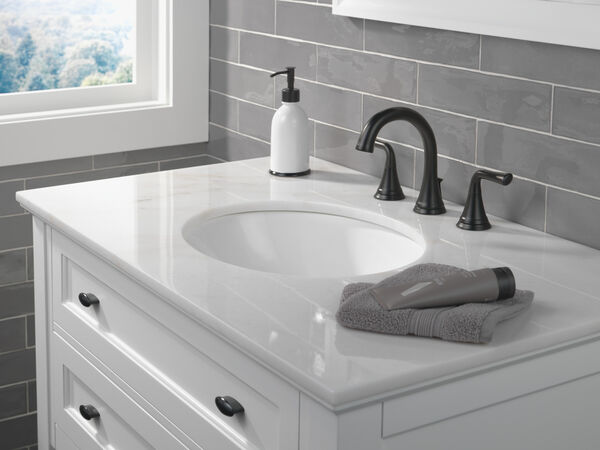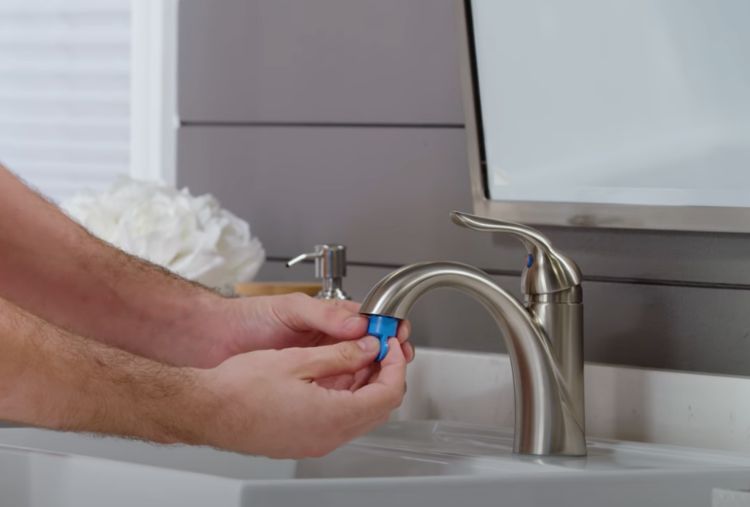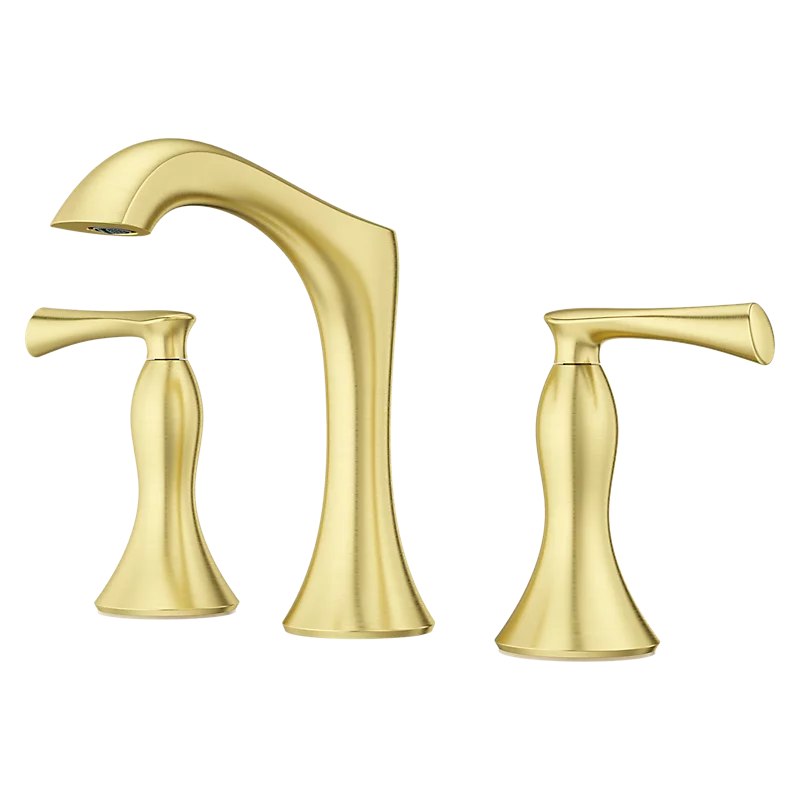Mix-and-match tiles, slim whirlpool tubs and easier-to-clean toilets are among 10 top trends from Italy’s Cersaie fair
Cersaie is an international exhibition of architectural ceramics and bathroom furnishings held every September in Bologna, Italy. This year, 840 exhibitors, including 452 ceramic tile manufacturers and 181 bathroom furnishings firms, showed off their new designs. More than a third of the exhibitors and nearly half of the 112,104 visitors came from outside Italy. We were on the scene to greet professionals at the Houzz booth and to stroll the venue in search of exciting new trends.
Much of what we saw at Cersaie carried forward trends we’ve already been talking about. Other innovations — like a new approach to whirlpool bathtubs — are responding to current needs or desires to live in smaller homes, disconnect and unwind, minimize consumption, and maximize personalization. Here are the hottest bathroom solutions for 2019.
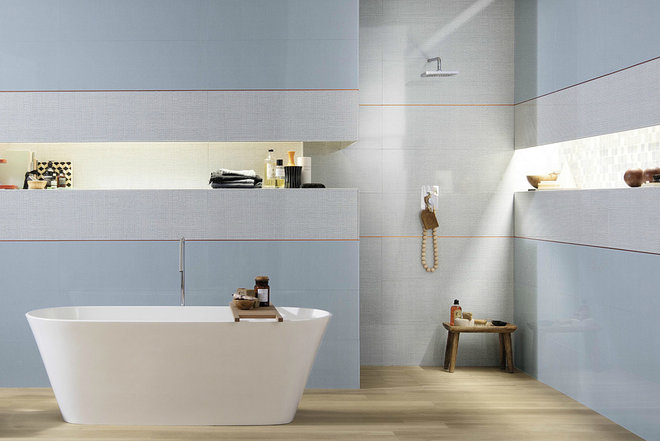
1. Mix-and-Match Tiles
Why limit yourself to just one size and shade for your bathroom tiles? Now the imagination can run wild with wall finishes that can be combined in personalized designs. Companies are coming up with collections of tiles in different sizes and finishes. The designs and colors go well with one another and can be mixed and matched, leaving lots of room for designers’ creativity.
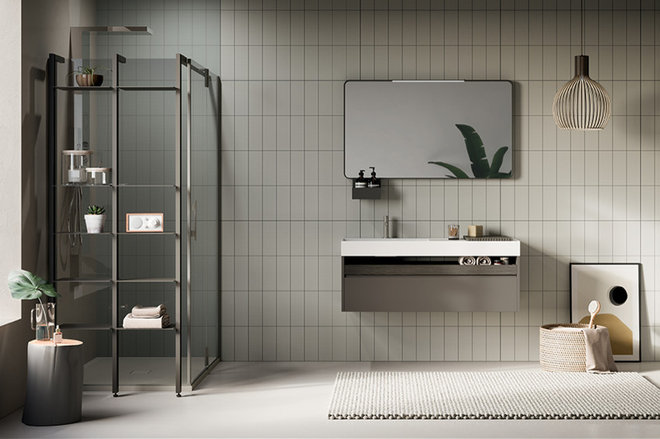
2. Stacked Tile Layouts
This year saw further experimentation with tile shape and size, but the classic subway rectangle, in several sizes, is still popular. Now we’re seeing it in a stacked vertical layout.
Once considered just a technical necessity, grout lines today play a leading design role and are purposely enlarged to contrast with the tile color.
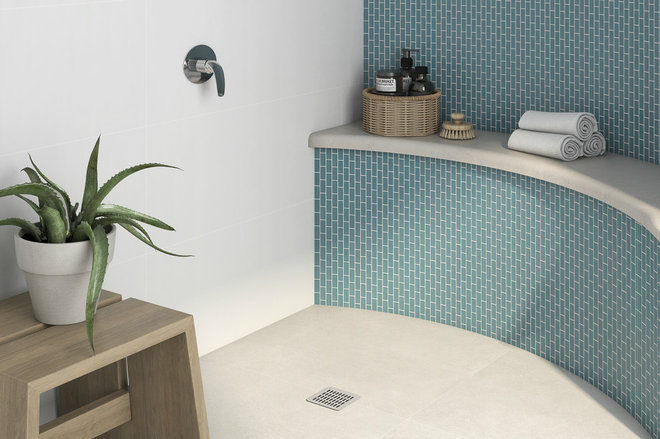
Rectangular mosaic tiles are a popular twist. A vertical brick layout is, again, on trend.
Rock Art mosaic tiles in Smart Aqua: Roca Tile
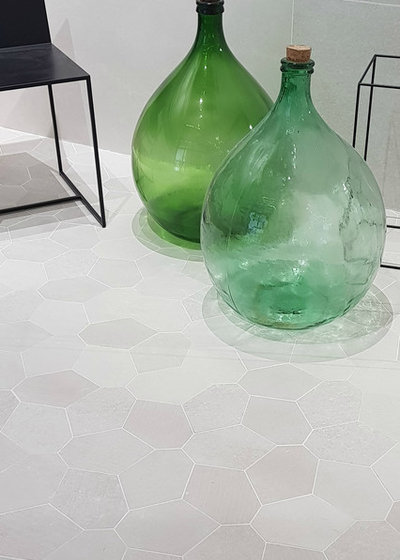
3. Asymmetrical Tiles
If you are in the mood for something different and find hexagonal tiles too static or mainstream, asymmetrical hexagonal tiles are a forward-thinking touch.
Esagona Irregolare tiles from the Abaco collection: Ceramica Colli di Sassuol
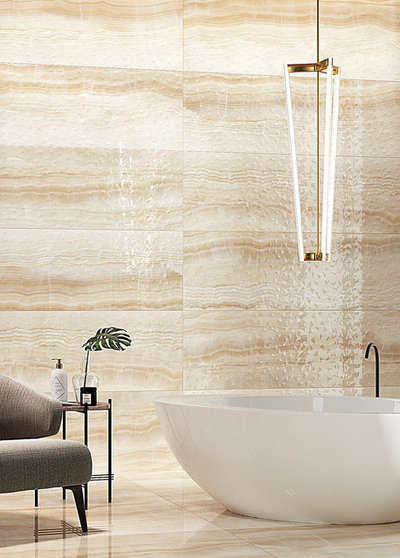
4. 3D-Effect Tiles
Relief patterns add subtle interest, especially to pure white tiles. At the fair, 3D textures also appeared on marble-effect slabs, such as these Infinity Honey Mirror tiles from Ascot Ceramiche’s Excelsior collection. They enliven the classic finish and give it a more contemporary feel.

Marco Paolelli of Meneghello Paolelli Associati, a design firm that collaborates with a number of companies in the bathroom furnishings industry, also sees a trend toward greater embellishment.
“Having studied the industry for over 10 years and looked around, I find that a need for normality collides with a desire to exaggerate,” Paolelli says. “On the one hand are simple, reassuring pieces with soft lines, and on the other hand [are] innovative collections that are abrasive in some ways and want to go beyond norms and evoke emotions. The material character of the product is experiencing its golden age. Marble ‘in,’ wood ‘out’; decor in all its forms ‘in,’ minimalism ‘out.’”
Bubble tiles in matte white from the Lumina collection: Fap Ceramiche
5. Stone-Effect Tiles
Natural-material purists may disagree, but there is a good case to be made for artificial stone slabs: resistance to wear and bacteria, relatively easy care and more. These Pietra d’Iseo tiles from Cotto d’Este are an example. The design is an imitation of a stone extracted from quarries near Italy’s Lake Iseo that was widely used in the palaces of Milan and elsewhere in Lombardy.
The tiles, however, are made of Kerlite, a thin, laminated porcelain stoneware that is reinforced with fiberglass. It also incorporates an antimicrobial technology designed to use silver ions to inhibit the metabolic processes of bacteria, preventing their growth. The ions are added to the tiles during firing, so they are permanently active in the product.
6. Pastel Colors
Gray, white and marble-effect tiles are still going strong for bathroom wall and floor coverings. But among the colors at the fair, sage green and pastel pink (along with marsala) predominated.
Shapes tiles in Leaf from the Even collection: Panaria Ceramica
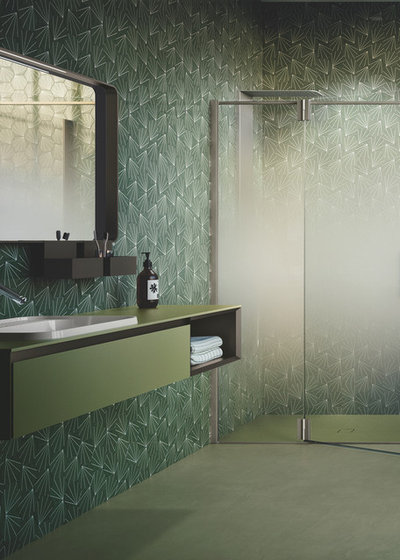
This was true not only for tiles, but also for bathroom fixtures and accessories, such as this green shower tray from the Colors collection by Agha.
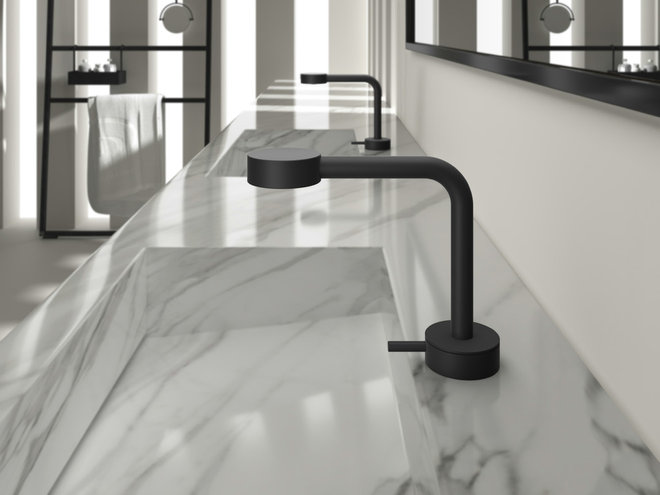
7. Black and White
Black-and-white bathrooms are always in. Faucet manufacturers are following this trend by offering sophisticated black (or white) as a standard option instead of an add-on to the chrome versions, for example.
Slim collection single-lever faucet: Cisal
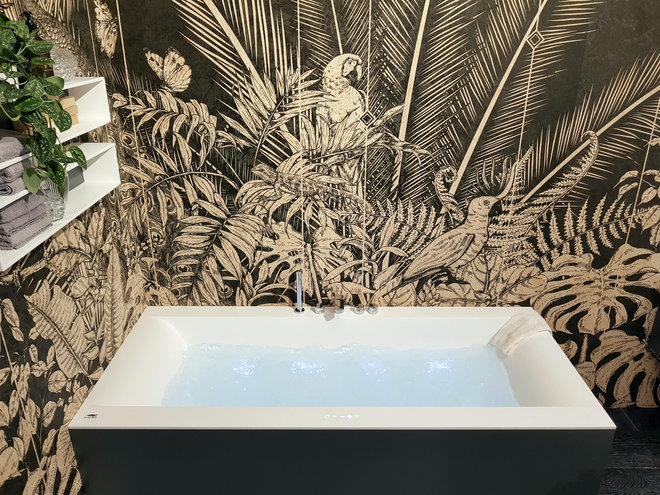
8. Thin Whirlpool Tubs
The bulky whirlpool bathtub is now fading into history, with new models that fit even into a small bathroom, thanks to innovative solid-surface materials that allow for thinner framing and more compact mechanisms. These tubs are also quieter, a feature that is not to be underestimated in a small space or an open en suite. What with freestanding and built-in tubs in oval and rectangular shapes, there’s a model to suit everyone’s needs.
Calle whirlpool tub: Hafro
This new Arga model from Jacuzzi does away with bubbles, replacing the air jets with a trademarked technology designed to generate gentler vortexes that caress the bather’s body. The tub also features a built-in bath-salt diffuser and lights.
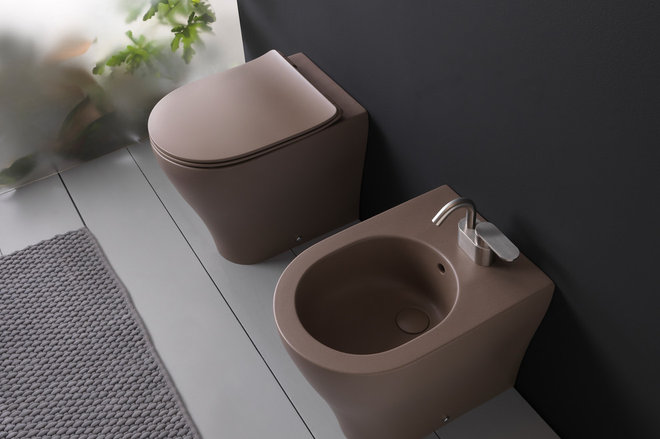
9. Rimless Toilets
Focusing on hygiene, new toilet designs included several rimless models — which make it easier to clean the bowl — with quick-release seats. For example, this model in Flaminia’s App line has a seat that can be removed with the touch of a button and a toilet without an internal rim. It’s shown in the new Fango color.
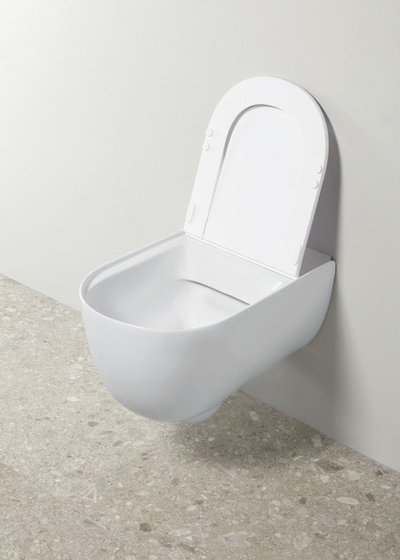
Another model is The One toilet by Artceram, designed by Meneghello Paolelli Associati. The ultrathin seat is hingeless and comes off easily, and the inside is rim-free.
10. Vessel Sinks
Vessel sinks reign supreme in company catalogs. They can be round, oval or rectangular, featuring either organic lines with finishes reminiscent of tumbled stone or a very thin and squared bowl for a more minimalist look. The sinks come in ceramic or solid surface, and the finish may be white or colored, or may resemble natural stone.
The most important element is a functional shape that reduces splash from the faucet. The support base is also key: A bowl-shaped sink sitting directly on the counter can be difficult to clean around. Solutions like these Lounge sinks, designed for Noken Porcelanosa Bathrooms by Simone Micheli, take this into account with their short pedestals.



